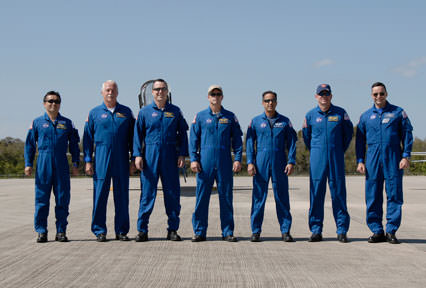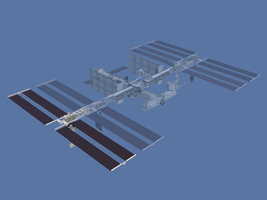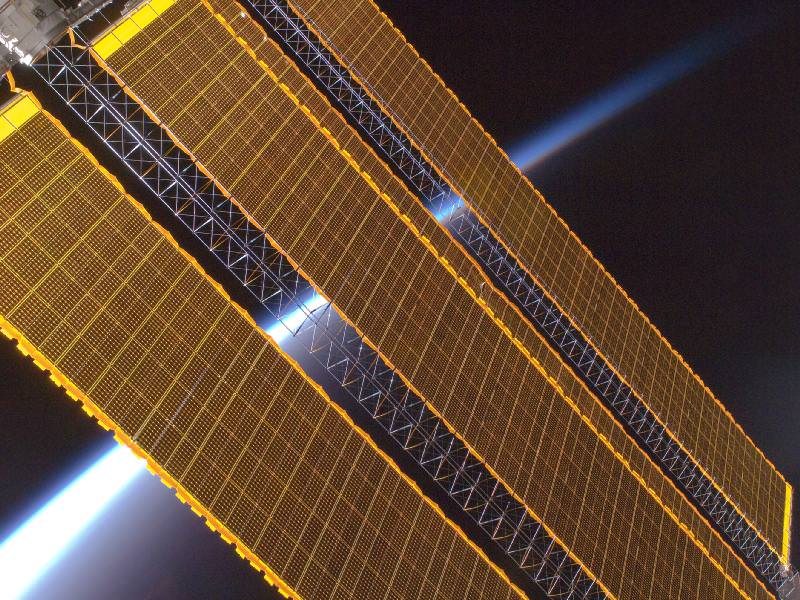[/caption]
Venus is about to be ousted as the brightest star-like object in the night sky. The next space shuttle mission, STS-119 is slated to launch on Wednesday night, March 11 at 9:20 p.m. EDT (1:20 a.m. Thursday March 12 GMT), and astronauts will deliver and install the fourth and final set of solar array wings to the International Space Station. Once the array is deployed, the station will surpass Venus as the brightest object in the night sky, second only to the Moon. The new array will increase the amount of electricity available for science experiments by 50%, providing the power needed for the ISS to house a crew of 6 astronauts instead of the current 3.
The solar array truss segment, known as Starboard 6 or S6 for short, weighs 14,000 kilograms (31,060 pounds) and measures 5 meters (16.3 feet) wide, 13.8 meters (45.4 feet) long in the shuttle’s cargo bay. Once deployed, the ISS will then have four panels on each end of its power truss. Total surface area of all the arrays will be roughly one acre, generating 84 to 120 kilowatts of useable power, depending on the time of year and angle to the sun.
“It takes up the entire payload bay, so unlike the last flight (in November), this is pretty much what our focus will be on the mission, getting the element installed and activated and the wings deployed,” said ISS program manager Mike Suffredini.
There are a few interesting aspects to this mission. Two teachers are part of the crew, but they won’t be teaching from space. Both Richard Arnold and Joe Acaba, who were selected by NASA as part of the educator astronaut initiative, will be conducting two spacewalks each – one of those together –to help outfit the S6 truss, preparing it for deploy.
“As an educator,” Arnold said, “you presumably believe in the notion that education can take you anywhere. Here we are. We’re knocking on the door. We’re about to go to space.”
They hope to demonstrate that educators can contribute as astronauts, just as well as military pilots, engineers and scientists. “Teachers have to think on their feet and be at their absolute best all the time,” Acaba said. “Our performance will speak a lot for the profession.”

STS-119 also will bring up Japan’s first long-duration resident of the ISS station flier, veteran Koichi Wakata, who has flown on the shuttle twice previously. He’ll be taking the place of Sandy Magnus who has been on board the station for the past four months.
Other crew members are Commander Lee Archambault, pilot Tony Antonelli, and Mission Specialists John Phillips, and Steve Swanson.
This mission has been delayed because of concerns about possible cracks in the three hydrogen flow control valves used to pressurize the hydrogen section of the external fuel tank. But the valves have now been replaced and so far, the weather looks favorable for Wednesday night’s launch.

By the time Discovery leaves the station, the mass of the ISS will increase to 669,291 pounds – 335 tons – and construction of the station be 81% complete. S6 is the last US-built piece of the station.
Despite the delay getting Discovery off the ground, NASA still hopes to launch five missions this year.
The Hubble repair mission is scheduled for launch May 12, and Endeavour returns to space around June 13 for a mission to attach an external experiment platform on the space station’s Japanese Kibo lab module. Atlantis is scheduled to fly again in late August, followed by Discovery in November or December.
Sources: CSA, CBS Space Place


get-er dun
It would be interesting to know the final magnitude of the ISS.
This is great news for people who like to dabble in astrophotography…the ISS passing overhead is a sight to see already…but with these new solar panels increasing its apparent brightness, this will make it easier for us amateurs to get better photos of the ISS…more light, faster shutter speed, less blur : )
When i point the ISS passing overhead with people who have never seen it before, it consistently blows them away ( and me too, it never gets old! much cooler than Iridium flares in my mind )….we all are very very lucky to be living in the Age of Spaceflight IMHO…
I smell new UFO´s cases after this!
Awesome. Hopefully we can survive the next Holocene catastrophe.
What kills me about the ISS is that NASA is done with the thing in 2015. After all of the time, effort, expense, diversion of resources, and some heroic efforts, we are only going to use the completed station for five years. Is it that cheaply built? We should have let the Mars Rover teams design, build, and operate the ISS. If the Rover teams had done it, Captain Kirk and Spock would be hanging out on the ISS for drinks. Babylon 5 would be known as the ‘other’ station.
When taking a photo of the ISS it will be extremely bright against the night sky. You could try to get a timelapse streak or time it to the half second with an appropriate background, try getting the moon or a planet in the same frame.
like http://antwrp.gsfc.nasa.gov/apod/ap090206.html
Make it a contest.
Stephen: that’s a truly amazing picture – thanks for the link!
Every mention of the ISS takes me back to the summer of 2007 when together with the Amateur Radio Experts we were able to organise a link up between Scouts of the World Scout Jamboree and Clay Anderson on the Space Station. – Really memorable.
I too would like a measure of the brightness after the addition of S6 and am getting geared up for an increase in UFO sightings.
Why are they having two teachers that have never flown in space install a multi-million dollar solar array?
Why is NASA going to bail on the ISS after 2015 when we (meaning the U.S. taxpayers) have spent so much money on this project?
I don’t have a problem with the ISS being so bright. It doesn’t come over that often in the first place and you could use the break to watch something cool and pour yourself another cup of coffee.
A new phase of the night sky light pollution has started 🙁
Would this be easily visible in the daytime sky?
Might con my wife into believing UFO’S if it does a day fly over. 🙂
“What kills me about the ISS is that NASA is done with the thing in 2015. ”
That’s been bugging me, too. Maybe “easily” separated assets like the solar panels can be removed and transferred over to some next generation station or satelite after all is said and done. Or sell the darn thing off to private interests that may have the capacity for mission control, etc. when the time comes.
it will be the 2nd “brightest”, if by bright you mean good idea, then i would have to disagree
dude, what problem do you have with the two teachers on this mission? Do you think that NASA would have them aboard if they were not qualified to accomplish the mission? Get over the labels.. What counts is whether the job at hand can be successfully completed. Not whether us “sit-around-wish-we could be there” wannabes think an astronaut has flown enough.
Gosh, from these comments, I see a lot of people who think they are smart, come here very often to live out their space-fantasies!
@ Marco
The political and financial situation as we approach 2015 might be more favourable to continued support, perhaps reconstitution, even expansion, of the ISS. Losing a mutlibillion dollar space complex – indeed our largest outpost – would be an absurd setback, especially with no christened replacement.
As was suggested before, boosting the ISS into a stable geosynch or geostationary orbit would be preferable to scuttling. Even transforming it into interplanetary spaceship might be worth our time, considering how expensive and risky it is to get equipment, let alone whole ships, into orbit.
My dear Mr. Jarrett.
I do not wish to be there. I like observational astronomy from the ground just fine, thank you.
I do want the most qualified people to take care of my taxpayer dollars.
“A new phase of the night sky light pollution has started :-(”
While it may be the brightest, this is not the first or only naked-eye satellite, you know…
I believe in minimizing light pollution too (both to preserve dark skies and for energy efficiency), but if you want flying machines (not just in space) there *will* be passive and active lights from them. Only the military ever has legitimate reason to fly ‘cloaked…’
I really enjoy the content of your blog, since I am a blog addict I shall return, lol
Being so excited about the ISS, and decaying it into a non-functional body by 2015, sounds and reflects a bit hastily planned mission to me. Investing so much, and then end up with so little of life of it, suggest better planning by NASA scientists and space gurus.